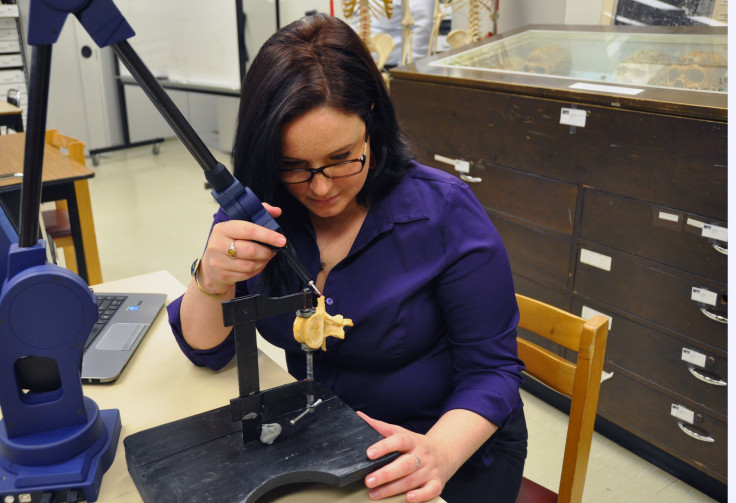Spines Of Back Pain Sufferers Resemble Those Of Chimpanzees More Than Humans

If you suffer from back pain like many humans do, it’s possible that your spine is less evolved than those who don't have back pain.
According to a new study published in the journal BMC Evolutionary Biology, there is likely a relationship between disc herniation — a common cause of back pain — and the shape of the spine. The researchers found that people who have back pain often have a lesion known as a “Schmorl’s node” lodged in between the bones of their spines. Their spines also tend to be closer in shape to the spines of chimpanzees than their other fellow humans. In other words, back pain sufferers may have gotten the short end of the evolution stick.
Ancestral Shape Hypothesis
Researchers from Scotland, Canada, and Iceland examined the vertebrae of chimpanzees and orangutans, then compared them to ancient human skeletons with the aim of establishing a link between humans’ ability to walk upright and their spinal health. Kimberly Plomp, a post-doctoral fellow and biological anthropologist at Simon Fraser University in Canada, analyzed vertebral shape, upright locomotion, and spinal health through 2-dimensional shape analyses of the skeletons.
“We have found that some characteristics of human vertebrae differ in shape between those individuals who have a lesion called a Schmorl’s node — a small hernia that can occur in the cartilaginous disc between vertebrae,” Plomp said in the press release. “The humans who have Schmorl’s nodes tend to have vertebral elements with a shape that is statistically indistinguishable from chimpanzee vertebrae.”
Schmorl’s nodes occur as a result of strain or stress on the spine (such as high-impact sports or lifting something heavy). They are essentially spaces in the vertebrae where the cartilage slips into the surface of the vertebral body, often causing inflammation, pain, and difficulty walking.
“As evolution occurred our vertebrae would have changed as we evolved, from using some form of quadrupedal locomotion [walking on four legs]… to bipedalism, using two legs,” Plomp said in the press release. “In short, our study suggests that the pathological vertebrae of some people may be less well adapted for walking upright.” As a result, these spines are more likely to suffer from the wears and tears of walking on two feet.
Nearly 80 percent of all adults will experience back pain at some point in their lives, according to the National Institute of Neurological Disorders and Stroke, making it one of the most common afflictions. It can be caused by wear and tear of the spine over time, or by a sudden strain like lifting something heavy. The NINDS also notes that sedentary lifestyles and lack of physical activity can exacerbate back problems like slipped discs. The best way to deal with back pain is to partake in low-impact physical activities, like swimming, biking, or walking.
The researchers' theory, known as the ancestral shape hypothesis, may explain some other spinal diseases like osteoarthritis. The researchers plan on examining the spines of more ancient and modern humans to further study the notion.
“This finding not only has clinical implications but also illustrates the benefits of bringing the tools of evolutionary biology to bear on problems in medicine and public health,” the authors conclude in the study.
Source: Plomp A, Viðarsdóttir U, Weston D, Dobney K, Collard M. The ancestral shape hypothesis: an evolutionary explanation for the occurrence of intervertebral disc herniation in humans. BMC Evolutionary Biology. 2015.



























